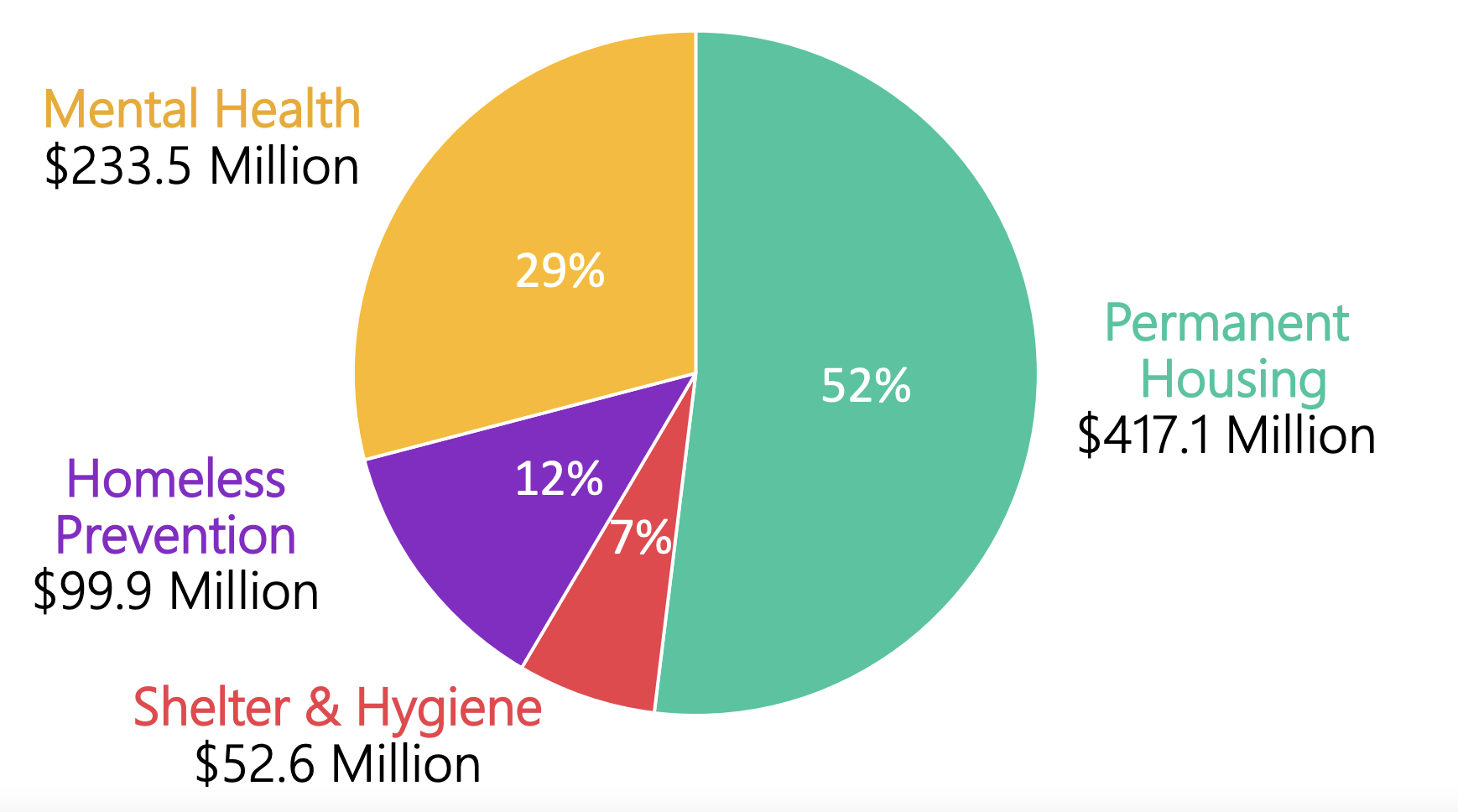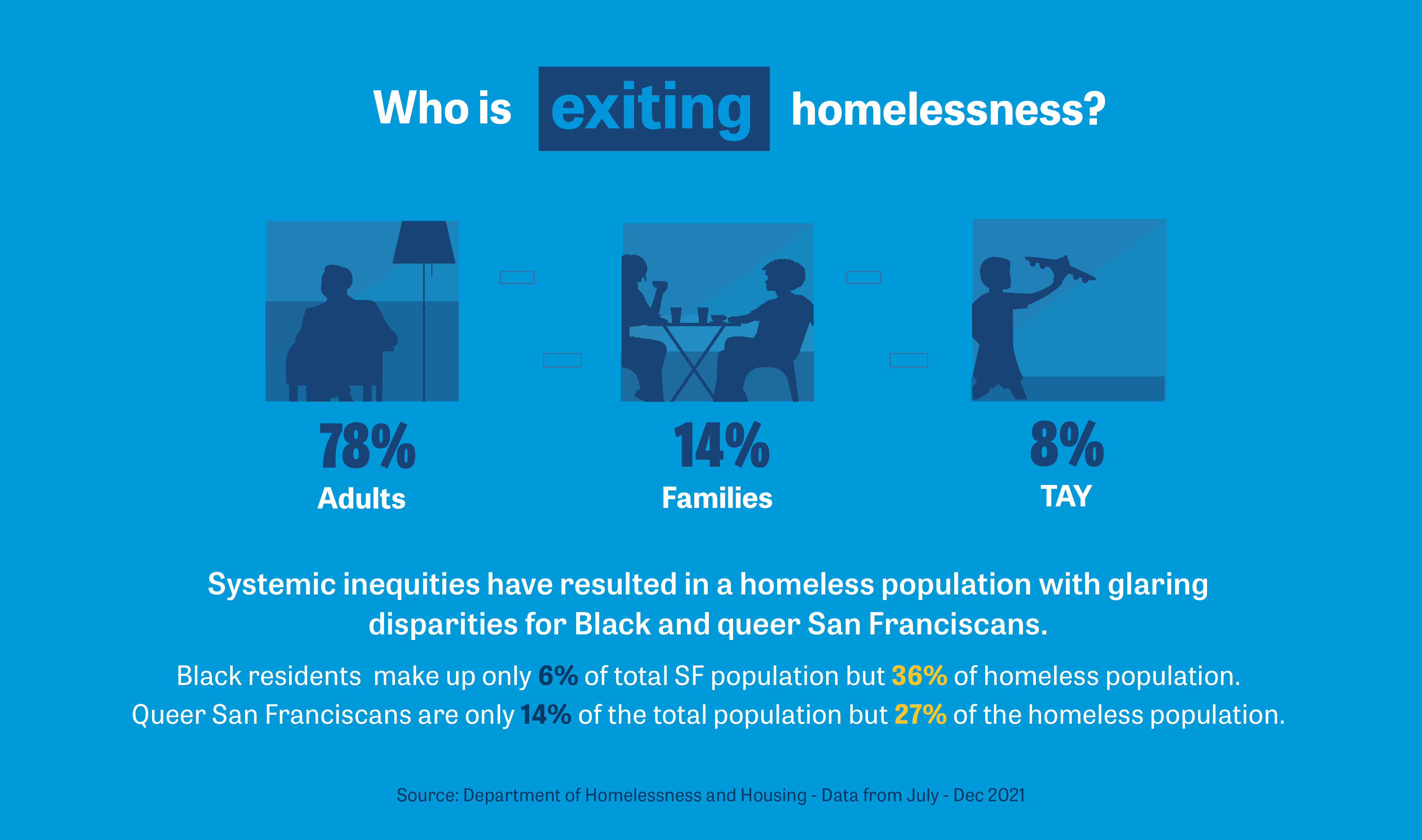From homeless to housed: March Snapshot
Every month, we track the number of people who exited homelessness in San Francisco so we can determine if we are on pace to meet our housing goals for the year. Staying on top of this information helps us ask the important questions – of ourselves and others – to make sure we are doing everything possible to get people off the streets and into homes.

In January, 121 people exited homelessness in San Francisco.
Last month, we wrote about the City’s proposed budget for homelessness in the next fiscal year. You may recall that we propose to make our largest investment ever–reflecting just how important it is to the City to address homelessness. But many people ask, rightly, where has that money gone? And why does it seem like more money does not equal more progress?
This month’s Snapshot tackles those questions head-on. We are taking a close look at how the funds allocated for this fiscal year have been spent. As a reminder, our fiscal year runs from July 1 to June 30, so we are about ¾ of the way through the fiscal year. And, as you know from prior blogs, Our City Our Home (aka Prop C) revenue makes up a large percentage of our City’s resources for addressing homelessness.

This is the first full year that we have had to deploy Prop C dollars, so we will focus here on how those resources have changed the landscape for homelessness resources.
Prop C adds approximately $300 million/year to the City’s coffers to spend on homelessness. But, because litigation precluded spending Prop C funds for a few years, we started this fiscal year with approximately $803 million in Prop C revenue, allocated as follows:

Where Has the Money Gone?
To date, we have spent or are projected to spend close to 70% of the funds on permanent housing this fiscal year. Notably, we have already added over 2,100 new housing slots, which includes the acquisition of six new buildings, totalling 690 new permanent supportive housing opportunities.
We have spent over 90% of funds allocated to shelter and hygiene, which has resulted in the creation of over 500 new shelter beds across our system of care. The funds have also allowed for the addition of different types of non-congregate shelter options, like the new vehicular triage center at Candlestick Park, which can be safely operated even during the pandemic.
And, it is not an exaggeration to say that Prop C has enabled the creation of an entirely new model of prevention. The City plans to spend approximately 75% of the prevention budget this year. Those funds will support 3,600 households in San Francisco, which means that 3,600 people have a far greater likelihood of avoiding the stress and trauma of homelessness. A greater emphasis on homelessness prevention is critical to ensuring that we see the type of progress we want to see as a community. We can and should be proud of every exit from homelessness that we see. But, if 2-3 people become homeless for every person we house, then we will remain stuck in a cycle in which it seems that no progress is being made.

Finally, we have spent, or planned to spend, only about 17% of the funds allocated to behavioral health. The Department of Public Health reports that they are quickly trying to implement their plans but that staff shortages and the length of time it takes to procure new sites has caused delays. Even with those delays, there has been some progress: 132 new treatment beds have been added to our system of care, and there are now 7 street outreach teams dedicated to responding to our neighbors in crisis. As a result of those new teams, 61% calls have been diverted away from law enforcement. In addition, SOMARise, a drug sobering center, is on track to open this spring.
Why Doesn’t It Seem Like More Money Equals More Progress?
For those of you who have lived in San Francisco for a long time, you know that we did not always have thousands of people making their homes on sidewalks and freeway underpasses. Rather, we started to see unsheltered homelessness when the federal government started to disinvest in public housing and the State shuttered mental institutions.. Economic pressure driving up the cost of housing, a total failure for the supply of housing to keep up with the demand, and the harms caused by structural racism have only made it that much more difficult for residents to secure and maintain housing.
Moreover, our homelessness response system has not evolved rapidly enough to meet the needs of people experiencing homelessness today. For example, we have a shelter system that is largely designed to deal only with emergency situations. As a result, typically individuals can only remain in shelter for 90 days even though we know that it takes longer than 90 days for someone to secure a safe and stable home.
The truth is that we did not get to this point where thousands of people live unsheltered overnight and won’t be able to house them all overnight.
What does all of this mean for housed and unhoused residents in San Francisco?
Well, to be sure, we have more capacity than we have ever had to address homelessness. And yet, we know that we still aren’t moving quickly enough to deploy our resources in ways that alleviate the suffering we see everyday. Frustration is building for housed and unhoused residents alike. We need to do what we can to ensure that all of these new resources translate to meaningful improvements in people’s lives.
Call, text, email your Supervisor or City official, not to complain that there is a tent on your sidewalk but rather to insist that we allocate the resources we now have for maximum impact so that we offer better options than our sidewalks for our unhoused neighbors. Our elected leaders need to know that we are all paying attention to the details, and that we will hold them accountable for tangible results.
We need you! All In is a campaign built on the people of San Francisco, and here’s how you can show up for our unhoused neighbors:
- Share this blog with three friends/colleagues on Facebook – Twitter to start a meaningful conversation about homelessness in our community.
- The solutions to homelessness start with YOU. Click below to sign the All In Pledge.
Stay up to date with the latest news about homelessness and housing in SF:
- Mayor Breed is not extending the Tenderloin emergency for S.F. drug crisis. What does that mean for the neighborhood?
- Board of Supervisors Question Evolution of Tenderloin Emergency
- The housing crisis is pushing both Bay Area landlords and tenants to the financial brink
- One Bay Area county says it could end homelessness this year. Can its approach spread?




